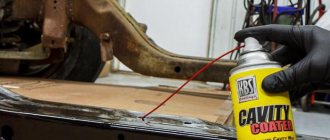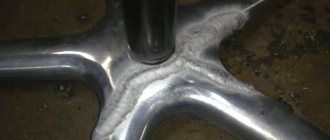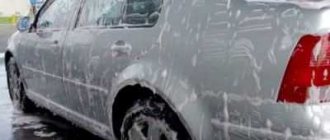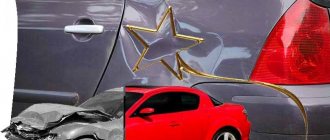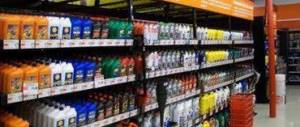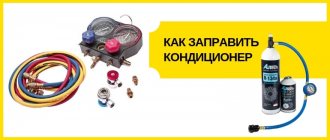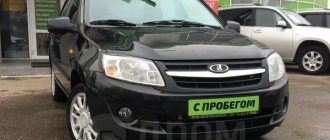What is anti-gravel
Anti-gravel is a special composition for protecting the car body. It is easy to use and does not have a negative impact on the appearance of the vehicle. A special balanced composition takes on the impacts of stones and other solid particles without collapsing. As a result, the risks of body damage are minimized.
Important! The most popular forms of anti-gravel release are aerosol and film. It is more convenient to use the product with a spray.
Anti-gravel, in the form of an aerosol, is a reliable material for protecting arches, sills, fenders, bumpers, and other parts of the car body from stones, salt and other negative external factors. After treatment, the coating will be reliably protected from mechanical deformation and the appearance of corrosion foci. The aerosol is filled with a polymer that retains its original plasticity regardless of ambient temperatures. As a result, a matte protective layer is formed on the surface of the body. The base is most often rubber or synthetic (resins). Rubbers resist deformation well. The most commonly used resins are phenol and urea. Their properties largely depend on the production technology used.
Important! Aerosol treatment with anti-gravel in cans creates additional sound insulation. Aerosols dry quickly, forming a film that is resistant to sudden thermal changes.
The composition must be applied to a dry and clean body, up to two layers. Allow at least 20 minutes between applications to dry. When the composition is applied, you need to wait a day and only then drive.
It’s easy to use anti-gravel, the main thing is to give it enough time to dry
Anti-gravity spray cans
Protective products in the form of an aerosol are an option for use at home. They are easy to apply, forming a thin film. The mixtures protect surfaces from mechanical damage and also have soundproofing properties. Such anti-gravels are made on the basis of synthetic resins, rubber or polyurethane. The editors of Vyborexperta.ru tested 8 candidates, and 3 winners showed the best efficiency.
HB Body 950
Anti-gravel aerosol with a volume of 400 ml “HB Body 950” is suitable for treating the underbody, sills, wheel arches and body. It is available in 3 colors: white, gray and black, which significantly expands the range of applications. The rubber-based composition forms an elastic coating with a high degree of protection against mechanical stress. A characteristic feature of the product is a pronounced soundproofing effect, which makes driving the machine as comfortable as possible.
HB Body 950 does not adhere well to smooth surfaces, so they must be carefully prepared by sanding and degreasing. Despite its liquid consistency, the product is easy to apply due to the formation of foam. After drying (this will take 24 hours), the surface becomes lumpy. Anti-gravel is compatible with alkyd, water-soluble and acrylic paints.
Advantages:
- Low price;
- Availability in the retail chain;
- Shelf life – 3 years;
- High efficiency;
- Well protects against corrosion;
- Versatility.
Flaws:
- Big expense.
Before use, the can should be shaken vigorously for 2 minutes. For strength, it is important to maintain a pause of 20-30 minutes between application of layers.
Novol Gravit 600
The product is intended for treating car arches, sills and sealing joints in the body. It is suitable for use with acrylic, reactive and two-component epoxy primers. The product has good adhesion to aluminium, steel, polyester putty, laminate and plastic. The composition based on synthetic resins is available in grey, white and black. The liquid is applied using a gun, which is attached to an anti-gravel spray can.
After application, Novol Gravit 600 forms a dense and elastic film with a fine-grained structure that does not dry out over time. It provides multi-stage protection of automotive surfaces from water, salts, oils and gasoline, stones and corrosion. Separately, it is worth highlighting the noise-absorbing properties of the product and its compatibility with acrylic varnishes. If the mixture is very thick, it can be diluted with a solvent.
Advantages:
- The break between applying the next layer is 5 minutes;
- Dries in 40-60 minutes;
- Low cost;
- Volume 1 l;
- Easy to apply.
Flaws:
- The composition lacks corrosion inhibitors.
Anti-gravel "Novol Gravit 600" is not recommended to be applied to suspension elements, exhaust systems, chassis and engine parts.
Astrohim Antiruster
...I bought Astrohim Antiruster to treat the lower parts of the body. The product really does an excellent job of protecting parts and does not lose its properties during frequent temperature changes and high frosts...
Expert opinion
An anti-gravel agent based on polyurethane forms an elastic coating that prevents corrosion and chipping on the bottom, sills, arches and other lower parts of the body. The protective film is resistant to road agents and acid precipitation. It does not delaminate even in severe frosts and sudden temperature changes. For effectiveness, it is recommended to use the liquid composition at a temperature not lower than +15°C.
Due to aerosol spraying, Astrohim Antiruster is applied easily, evenly distributed over the entire area. The polyurethane mixture has good adhesion to most car enamels, which can be used after the composition has dried. If the task is to treat parts after coating with paint and varnish, then it is necessary to wait 7 days. Anti-gravel for cars is supplied in a 1 liter can. You can choose white, black or gray.
Advantages:
- Affordable price;
- Drying pause between layers is 10-15 minutes;
- Time until completely dry: 2 hours;
- Low consumption;
- The presence of sound-absorbing properties.
Flaws:
- Not detected.
Types of anti-gravel
To answer the question of which anti-gravel is better for a gun or an aerosol, you need to understand the existing types in principle. Types of compounds:
- taking into account texture - smooth or textured;
- for painting - allowing and not allowing it;
- in terms of application - for arches, sills, bodywork.
Textured anti-gravel in cans are optimally suited for application to plastic surfaces. Before starting work, you need to study the set of parts for which a certain product should be used.
Anti-gravel compounds in cylinders require application in several layers, are transparent, and therefore do not in any way affect the aesthetics of the body, sills, and arches. The finished film will be dense, reliable and durable. The price depends on the brand and the specific product. There are colored spray cans. The composition for the gun is not as convenient as a balloon one; it must be mixed with solvents before use.
Important! Cylinders are a professional choice; with the help of such products you can solve a wider range of problems than with the use of aerosols.
Spray cans are the most convenient option; they are usually transparent, but can be black
Banks with anti-gravel compounds are used least often. For application use a spray gun or roller. With the right approach, you can get decent results.
How to apply anti-gravel?
Before applying anti-gravel, you should know some nuances:
- First, the surface is treated (it must be degreased).
- Adhesive tape is placed along the paint borders.
- It is better to apply the coloring composition in 2-3 layers.
- Between layers take a break of several minutes and shake the can.
- The optimal layer of applied coating is 1 mm.
After applying anti-gravel, when the surface is completely painted, the car is left to dry. How long it will take for the protective coating layer to dry depends on the temperature, but not less than 2 hours.
What will the experts say? (2 videos)
Which anti-gravel for cars is better?
A review of anti-gravel with a rating will allow you to understand which product is more convenient and better to use. The most popular option is spray cans, as they are the easiest to use. It is advisable to take into account the chemical composition when choosing, since it may vary.
Which anti-gravel is best for arches
It’s most convenient to spray curved arches with spray cans; you can use a spray gun, but this is a more labor-intensive method. Eventually you will need to sand down the areas of the attachments with sandpaper.
Important! During work, glasses are used to protect the eyes. They will also prevent the ingress of dust and pieces of rust that fly in different directions.
After treating the arch with a spray can, you need to go over the surfaces with a nitro solvent and cover the remaining areas with masking tape. The pendant is wrapped in polyethylene for similar reasons.
Car arches must be protected; it is most convenient to use anti-gravel in cans to solve such problems
Which anti-gravel is best for thresholds
Thresholds should be protected with bitumen-based compounds and painted. Work can be carried out regularly, including immediately after purchasing a car. Protection wears out over time; factory protection is often simply not enough. Aerosols are most convenient to apply to thresholds. The products in the cans are used directly on bare metal, the adhesion is excellent. If everything is done correctly, a protective, reliable film will be formed that prevents corrosion.
This is what car sills look like
Anti-gravel rating
The most convenient way to select anti-gravel for sills, arches, and other parts of the body is by rating. The list includes the most popular products of different price categories.
The best premium antigravels
Premium products are the best in their category, but they have an important disadvantage - a high price. Popular options worth considering:
- Dinitrol 479 is a universal composite and liquid sound insulator. Suitable for processing sills, underbody, fender liner. The action is traditional for class products, adhesion is excellent, resistance to chemicals and corrosion is also good. During application with a spray can or under the gun, it does not flow. Two layers are enough, one is often enough too. Prices from 1100 rubles.
- Liqui Moly Steinschlag-Schutz is a synthetic-based product, black in color, gray when sprayed from a can. Suitable for application on varnished and untreated surfaces. It absorbs noise well, is highly resistant to abrasion and is also resistant to UV rays. Price from 1200 rubles, pleasant aroma.
- Hi-Gear – the properties of almost liquid rubber, application with fine grain, the finishing film is very elastic. The transparent composition does not change the shade of surfaces. Price from 900 rubles.
The main disadvantage of the group's products is that they are expensive, especially if you need to treat the car completely.
The best mid-price antigravels
A good anti-gravel aerosol is not always expensive. Examples of affordable products in cans:
- Body 930 – contains rubber and bitumen; it can be used to treat sills, arches, and the bottom. The protection is reliable, the noise-absorbing properties are high. The structure is quite thick, so application is possible with a brush and spray gun. Layer – 0.5-4 mm. The structure is fine-grained. The composition does not crack in the cold. Price starts from 320 rubles per liter or cylinder, there are different packaging.
- Body 900 is the most gentle anti-dust product; it is applied to the car body directly onto the paintwork. The can is suitable for treating side members, thresholds, doors from the inside, headlight sockets, arches, etc. Penetrates even into hard-to-reach places and displaces moisture from there. The cost of a cylinder is from 410 rubles.
- Novol Gravit MS 600 is a synthetic Polish product, the price-quality ratio is optimal, the application is uniform, the grain size is medium. Different colors - gray, black, white. There are no complaints about the strength of the finish - the film has excellent adhesion and high elasticity. Sound insulation properties are pronounced.
The downside of average cans in terms of price is the lack of corrosion inhibitors.
The best low-price anti-gravel products
Inexpensive is not always a bad thing, and budget cylinders are the best proof of this. Product examples:
- Kudo is a product with decent performance characteristics and is affordable. Apply it at a temperature of 10 degrees or more, first shake the can thoroughly. Up to two layers are needed with short drying times in between. The price of a can is about 200 rubles.
- Astrohim is a universal professional composition that reliably protects body paint and varnish materials from abrasions, scratches, chips, the appearance of bitumen stains and the formation of other defects. Suitable for processing glass, plastic, metal, the coating will be transparent matte. The cost of a can is 250 rubles.
- Kerry – the composition has a shagreen effect and performs two functions, namely it protects against damage and rust. Adhesion is high, sound vibrations are absorbed well by the protection. Parts that do not need to be processed are first covered with masking tape. The price is about 200 rubles.
Cheap cans are not bad, they cope with the tasks, but they will not solve additional purposes - only medium-level protection.
Types of anti-corrosion agents
Types of products depending on use.
When deciding which anti-corrosion agent is best, first of all keep in mind that the products differ in different parameters, one of which is the place of their application. According to the intended use, anticorrosive agents can be divided into two large groups.
For hidden surfaces.
An anti-corrosion agent for hidden surfaces must have the following properties:
- high degree of adhesion (adhesion between the surface of the car and the product);
- homogeneous structure;
- film elasticity;
- fill microcracks and damaged areas invisible to the eye;
- prevent the ingress of electrolytes and moisture.
Usually made on the basis of oil or paraffin. They are in a liquid state. These anti-corrosion drugs have a long shelf life.
For external surfaces.
These products protect the body, underbody, and wheel arches from corrosion. Basic requirements for them:
- protect from exposure to electrolytes;
- have the highest degree of adhesion;
- be elastic;
- withstand mechanical deformation;
- do not peel off;
- don't crack.
The most common of these products are bitumen mastics, made on the basis of synthetic and bitumen resins; liquid plastic, rubber-based coatings.
Classification by application methods, composition
If you are thinking about the best way to treat the car body against corrosion, then, of course, choose anti-corrosion protection for external surfaces. Anticorrosion agents for easily accessible car parts are produced as follows.
Bitumen mastic
Produced on the basis of resins, it protects the surface from mechanical stress and has the property of preserving metal. Apply it in a layer of 250–400 microns. Inhibitors that slow down the corrosion process and dispersed metal (previously aluminum, now more often bronze, zinc) can be added to the composition. They perfectly protect the body from environmental influences and mechanical damage. They serve as good noise insulation, reduce the level of vibrations of body elements and the resonance frequency of parts.
Anticorrosive based on PVC, rubber
The most durable anti-corrosion product, applied in the factory. The polymer is melted and then applied to a metal surface. A very elastic product with high adhesion.
Liquid plastic
Product with low mechanical resistance. Suitable for sills, wheel arches, front part of the hood as additional protection. It is not recommended for use on the body as a primary means of protection.
Slate mastic
It will help to solve the problem, what is the best way to treat the underbody of the car. It is used on the lower parts, when processing wings, and the inner surfaces of wheel arches.
Anti-gravel
Creates a layer that prevents mechanical stress and rust. Suitable for processing bumpers, thresholds, spoilers, doors.
The following anticorrosives are applied to hidden parts of the car:
- Non-drying, oil-based formulations. The anticorrosive agent remains in a liquid state after application and fills microcracks and scratches.
- Paraffin-based compositions. After drying, an elastic film is formed. The drug retains its anti-corrosion properties even under severe temperature changes.
Tips and tricks
Treating arches, sills, and underbody is a good way to prevent paint damage. The cost of such treatment will largely depend on the price of the product, especially if the entire body requires maintenance.
Important! Anti-gravel in cans is used approximately once a year - usually this is enough.
For everyday amateur use, ordinary spray cans are sufficient, so there is no point in paying for professional products. Universal formulas are effective and practical, you can safely stop at them. When choosing, you should pay attention to additional effects such as shagreen, graininess. The type of application is chosen taking into account the nature of the work, the area of protection must also correspond. Ideally, the higher the adhesion, the better.
